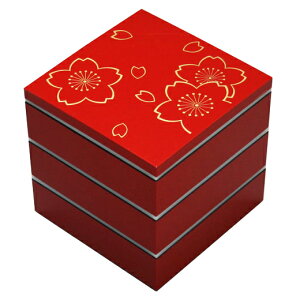おせちりょうり(Osechi-ryori)
Traditional Japanese Food for New Year

おせち料理
おせち料理は、伝統的なお正月のお料理です。
日本では、「三が日(1月1-3日)」の3日間は特に大切な「お休み」です。
その間、家事・料理をしなくてもよいように、「おせち料理」は保存がきく食べ物が
集められています。
保存しやすいように、お砂糖をたくさん使います。味付けも少し濃いめです。
全部つくるのは大変なので、一部をスーパーで買ったりします。
デパートやレストラン、オンラインで買う人もいます。
イタリア料理、フランス料理のものや、中華料理のものもあります。
スーパーで材料を買うとき、12月28日頃からは材料が値上がりします。
また、スーパーにたくさん人が来て混雑します。
日もちするものは早めに買った方が良いですよ!
はいっているもの
おせち料理のなかから、特に子どもが好きなものをピックアップしました。
それぞれに、家族が幸せになるための意味がこめられています。
作らない人も、意味を知っていると、おもしろいですよ。
黒豆
豆には「健康」や「丈夫」という意味があります。
黒豆をおせち料理に入れるのは、「まめまめしく働くように」という意味があります。

紅白のかまぼこ
紅白(赤と白)は、おめでたい色だからです。

栗きんとん
色(金色)が宝のような食べものです。「豊かな年になるように」という意味があります。

「重箱」にいれます
おせち料理は、「重箱」という特別な器に入れます。
- 3日間食べるので蓋つきだと便利
- お正月に挨拶にくるお客様用の食事なので、重箱に入れて用意をしておく
- 「重」には「重ねる」という意味があり、「福(良いこと)が重なる」というおめでたさ
などの意味があります。
もともとは4段ですが、最近売っているものは3段が多いです。
それぞれの段にも意味があります。
- 1段目:一の重 「祝い肴」という、お祝いの食べ物をつめます。(黒豆、数の子、手作り、かまぼこ など)
- 2段目:ニの重 「口取り肴」をつめます。(きんとん、だてまき、昆布巻きや、なますなど)
- 3段目:三の重 「海の幸(海でとれるもの)・焼き物」をつめます。(えび、ぶり、いかを焼いたものなど)
- 4段目:与(四の重) 「山の幸(山でとれるもの)・煮物」をつめます。(野菜の煮物など)
色、サイズ、材質、いろいろな重箱があります。お正月以外にも使えるものも人気があります。
「ワンプレートおせち」も人気です
「重箱」を持っていない、重箱に入れるほどの量を食べない人には、
普段使っているお皿にもりつける「ワンプレートおせち」も人気です。
お正月らしい小皿や飾り付けを使うと、雰囲気も出ます。

お正月の料理は特別なお箸で食べます
お正月には「祝い箸」という特別なお箸を用意します。
- 両方が細くなっています。片方は神様用、もう片方は人用という意味で、「一緒に食事をいただく」という意味があります。
- 大切なお箸が折れないように、「柳」で作ってあります。折れにくい木だからです。
- 箸袋には1人1人の名前を書きます。
4は日本語で「よん」「し」と読み「死」を連想させるので4本入りの箸は売っていません。
おせち料理のつくりかたをおしえてくれるYouTubeもあります。

New Year’s Day is the biggest holiday of the year in Japan, and it is the time when families and relatives
get together to celebrate and welcome the start of a brand new year.
The most famous traditional food of the New Year is Osechi-ryori.
Osechi is eaten from the 1st to the 3rd of January, and it is traditionally made with lots of sugar
for longer preservation, so that no one will need to work to cook during this holiday season.
The fact is - many still need to cook :(
It is difficult to make everything, so many purchase some at supermarkets,
or we can order at departments, restaurants, and online.
There are even Italian, French, and Chinese osechi-ryori.
Prices of the ingredients for osechi-ryori increase from around 28th. December.
Supermarkets get so crowded as well - make sure you get what you need if they can be purchased in advance.
What Are In Osechi-ryori?
Each content of Osechi has meanings so the family will be happy in the year to come.
Here are some typical Osechi dishes;
Black beans ("kuro-mame")
Beans have a sense of "health" and "strength", and this dish comes with a wish for a healthy and hard-working
life.

Pink and white fish cakes ("kamaboko")
This represents colors of red and white for celebration.

Sweentened yellow chestnuts and paste ("kuri-kinton")
As its outlook like a golden treasure, this comes with a prayer for a wealthy year.

Special container called "jubako"
Osechi ryori is served in a special container called a "jubako".
- Since it is to be eaten for three days, a lid is convenient.
-
Osechi is a meal for guests who come to greet on New Year's Day, so it should be prepared in advance in
a special container. - The word "Jyu" means "to pile up," and is used to express piled up happiness.
Originally, there were four layers but most of the ones sold these days have three layers.
Each tier also has its meaning;
-
The first layer is called the "ichi-no-ju" and is filled with congratulatory foods.
(Black beans, baby sardines, kamaboko, etc.) -
The second layer is the "ni-no-ju" and contains the appetizers.
(kuri-kiinton, datemaki, kombu maki, namasu, etc.) -
The third layer is called "san-no-ju" and comes with seafood (mostly grilled seafood).
(Grilled shrimp, yellowtail, squid, etc.) - The fourth layer is called "yo-no-ju" and contains "food of mountains" such as vegetables.
"Jubako" has a variety of colors, sizes, and materials.
Many like those that can be used for other occasions than new year.
"One-plate style osechi"
For those of us who do not have "jubako" or do not need that much osechi-ryori,
"one-plate style osechi" can be an option.
We can enjoy festive atmosphere by utilizing small plates and new-year decorations.

Special chopsticks for new year - "iwai bashi"
We prepare special chopsticks called "iwai bashi" that mean "celebratory chopsticks".
Both sides are thin and serve for eating.
One side is for the gods and the other side is for people, and they mean that gods and people will eat together.
The chopsticks are made of willow so that they will not break in celebrations of new year.
We would write names of each one on the chopstick bag.
We will not find a package of four bags of chopsticks -
because the number four is read as "yon" and "shi" in Japanese, and "shi" is associated
with the word "death" (pronounced "shi").
We can find various tutorials on YouTube;

Styling is difficult and important - and this is how an expert does it. Impossible at home, but isn't it gorgeous?

More about New Year;
"Japanese New Year" on Japan-Guide.com
"New year in Japan: traditional foods,
mochi, customs, games and new year cards" on Facts and Details
"Japanese New Year Customs" on notesofnomads






